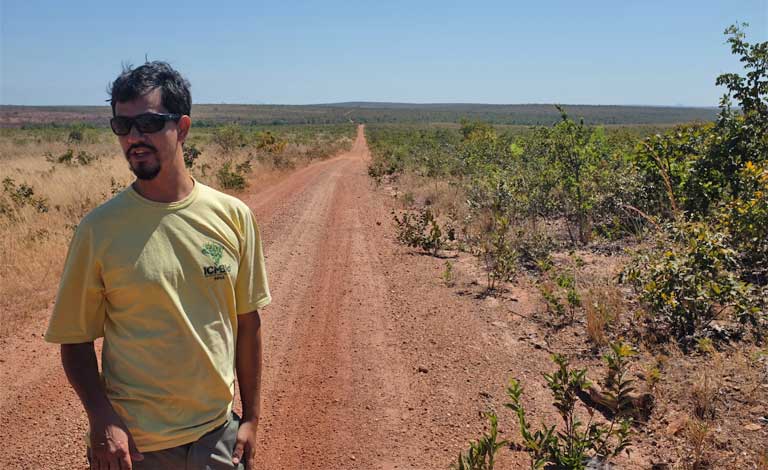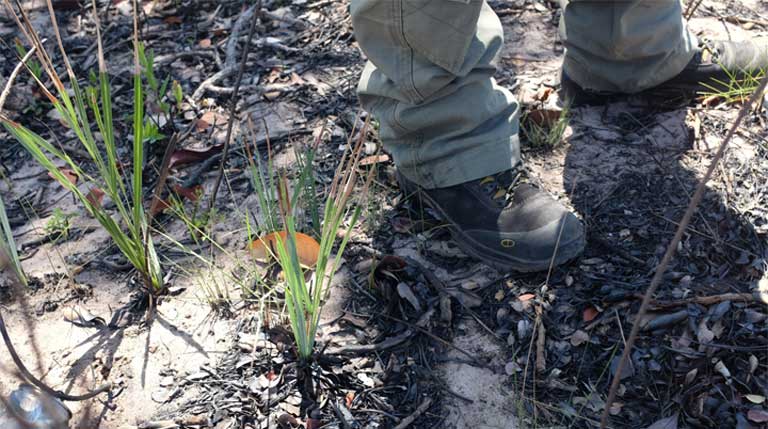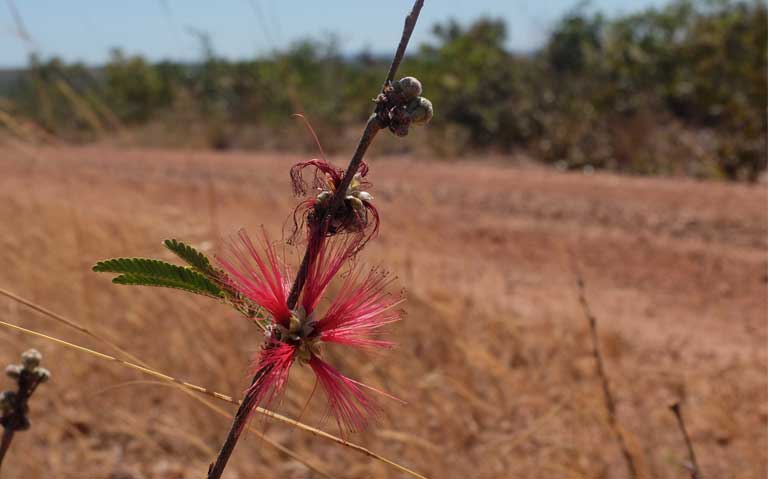- Fire is a disturbance that has occurred naturally in Brazil’s tropical savanna — known as the Cerrado biome — for thousands of years. Indigenous and traditional people living in the Cerrado taught themselves to work successfully with fire, using it as an environment-enhancing land management tool.
- However, modern land managers, influenced by techniques practiced in European and U.S. forests, imposed a non-alteration “zero-fire” conservation policy for decades in the Cerrado.
- That practice allowed the steady buildup of combustible organic material, which frequently led to late dry season wildfires or even mega-fires, ecosystem harm, and conflicts with traditional peoples. But in fact, a new study shows prescribed burns in the Cerrado cause no net loss in species diversity, and even enhance some species.
- Starting in 2014, pilot projects launched by the government on conserved lands I the Cerrado have successfully utilized Integrated Fire Management (IFM), including prescribed burns — approaches learned in part from traditional communities. The result is a decrease in wildfire size, intensity and ecosystem damage.

RIO DA CONCEIÇÃO, Tocantins, Brazil: After a bumpy hour-long drive, we arrive on a hilltop overlooking a buffer zone at the edge of the Serra Geral de Tocantins Ecological Station in the Brazilian Cerrado — the world’s largest tropical savanna. Getting out of the car, the August heat hits us like a blast furnace.
Marcos Borges, the preserve manager, points to our right at acres of exposed, charred black soil just inside the boundary of the park, the result, he said, of a recent wildfire burning so hot that all vegetation was destroyed. Crossing the road, Borges gestures downslope to parkland and more burned vegetation. But this scene isn’t nearly so desolate — the land forms a char-black and vibrant-green mosaic, stretching away as far as the eye can see.
“This is where we burned it,” he says, referring to a prescribed burn. Borges taps a small, grey, gnarly stump, and draws our eyes to a tuft of new, green shoots poking up from it. “Sometimes I feel like a painter on this landscape!” he exclaims. “Except that here I’m painting with fire.”
A mere decade ago, expounding this “fire friendly” doctrine would have been scientific heresy. For decades, Brazilian land managers had applied a rigid “zero-fire” policy for all biomes, an approach born out of the global rainforest conservation movement of the 1980s, when non-alteration of tropical landscapes became gospel. All fires were then deemed detrimental to ecosystem conservation — meaning that all fires must be aggressively suppressed; no exceptions.
While this one-size-fits-all management approach did work in the neighboring Amazon biome, it didn’t function well in the Cerrado. There, change — brought by regularly occurring fires — had been the natural order for many centuries. And as a result, the “zero-fire” policy brought disastrous consequences both ecologically and socially.

A new, centuries old, paradigm
Today, Borges — who works for the Chico Mendes Institute for Biodiversity Conservation (ICMBio), Brazil’s park service — along with others, is strongly questioning the “zero-fire” paradigm in Brazil’s savanna, where there is also growing recognition that officialdom can learn much from local indigenous and traditional communities whose controlled use of fire has long been deployed for conservation and land restoration.
Starting in 2014, Brazil tapped into that traditional fire knowledge. The federal government, with support from the German government, launched pilot projects within three protected areas in Brazil to test the effectiveness of Integrated Fire Management (IFM). The pilots were to use prescribed burns and other techniques in an attempt to reduce the prevalence of wildfires, protect fire‐sensitive vegetation and diminish conflicts between parks and local communities.
Program results so far point to much needed land management changes that could have vast benefits for the conservation of the world’s largest tropical savanna — especially as climate change and deforestation there cause intensifying drought. In fact, a just released study found that prescribed burns in the Cerrado result in “no net loss of species diversity,” and have “a positive effect on richness of graminoids [herbaceous grass-like plants] in grassland.”
Borges doesn’t mince words as to the importance of this shift: “Fire has revolutionized our landscape management here,” he told our Mongabay reporting team on a visit to Serra Geral de Tocantins in 2019.

Fire and the Cerrado: perfect together
The Cerrado is Brazil’s second largest biome, covering almost a quarter of the country’s landmass. But since the 1970s, mechanized agribusiness has converted more than half of the region’s natural vegetation to commodity crops, especially soy.
Scientists estimate that only 20 percent of the Cerrado’s natural vegetation remains intact, much of it in the four most northern Cerrado states of Maranhão, Tocantins, Piauí and Bahia. But these same states have also been dubbed “Matopiba,” a designation by soy producers demarcating the country’s last agricultural frontier.
As might be expected, the goals of soy farmers and conservationists clash here. Adding to the problem is that unlike in the Amazon, there is little protected land in Matopiba. The Serra Geral do Tocantins Ecological Station is an exception. It preserves some of the savanna’s last major swaths of native vegetation — a biodiverse island within a sea of soy.
Like some other protected areas in Brazil, it is also home to traditional peoples, who historically have been at odds with the zero-fire policy of the federal government. “The protected areas are a bit of a paradox in the Cerrado. They are occupied; there were people living there, quilombolas, traditional families,” says geographer Ludivine Eloy, who has studied the recent shift in fire management policy. “And then [the government] came and made a park over top of them and forbade them to use fire and to manage their lands in a way that had actually allowed the [native] vegetation to be preserved.”
The Serra Geras do Tocantins Ecological Station is just such an example. It was created in 2001 largely to protect the more than 1,000 natural springs that bubble up there, as well as the streams that flow through the park. However, when the preserve was established the land was already occupied by 40 traditional families. Some were organized quilombos — settlements of runaway slave descendants — while other traditional people lived more apart. But all had been managing the landscape for many decades, successfully using their own traditional ecological fire knowledge. However, “when the zero-burn policy started, they lost production and were criminalized,” Eloy recalled. In some areas, small-scale farmers resisted, but “they were fined; people got depressed; it turned violent.”
Like other grasslands and savannas around the world, the Brazilian Cerrado was shaped for centuries by long periods of drought and frequent fires, historically caused by lightning, and later also intentionally set by indigenous and traditional peoples living in the region to enhance hunting and agriculture. Almost three-quarters of Cerrado vegetation biomass is hidden underground, leading some scholars to dub the biome the “underground forest.” As a result, the frequent “cool” fires sweeping across the landscape did little damage to deep roots, while those blazes also fertilized the soil with char, aiding new growth that took off with seasonal rains.

Centuries of fire also shaped the plant and animal species that thrived in the Cerrado. The savanna — even with half of it gone — is today considered a “biodiversity hotspot” because of its high levels of endemism; of the approximately 10,000 plant species found in the Cerrado, almost half are found nowhere else on Earth.
Much of that species richness is linked to fire. Studies show that many species diverged and evolved in tandem with the onset of short grasses that fueled more fires. Today, most of the Cerrado’s dozens of unique ecosystems are considered fire adapted and fire-dependent — meaning that without the presence of fire, they can dissapear. Dogged fire suppression, like that practiced in recent decades, did serious harm to these ecosystems.
Eloy isn’t surprised at Brazil’s long imposed zero-fire policy. “There are very few people in Brazil with real knowledge of the Cerrado,” she explained. “Officials have always heard that fire is bad, and most of the ecologists — people that make political policies around the environment in Brazil — were trained in coastal areas with forests, or in Manaus, in the Amazon rainforest,” she told Mongabay. Plant and animal species in both the Atlantic Forest and Amazon biomes evolved without fire, so these were biomes where fire, regardless of size or intensity, almost always had negative consequences.
It took decades of seeing the consequences of the zero-fire policy on Cerrado vegetation, plus several ecologically devastating “hot” fire events, and increased conflict with local farmers and traditional communities, in order for officials to begin realigning their views.

Looking to the past to manage the future
In May 2010, Brazil experienced one of its worst ever fire seasons. From May to September, 57,700 blazes were registered in the Cerrado alone; three and a half times more fires than the year before. National parks saw severe burning, with up to 91 percent of their total area destroyed in some cases.
Blame was placed on local farmers despite the fact, as both Borges and Eloy point out, that the type of low-intensity fires the farmers use differs greatly from the sort of high-intensity wildfires seen in 2010. Today, experts put the true blame on the zero-fire policy, which allowed a buildup of combustible material over large swaths of land. It was a human-caused and natural disaster waiting to happen.
After the devastating 2010 fires, the Brazilian Ministry of the Environment, began to recognize the danger inherent in the Cerrado’s zero-fire policy, connected in part to a wider global recognition that in fire-prone savanna ecosystems, eliminating landscape fires was not only ecologically unsound, but also socially and economically unviable.
“The [old] fire management model in Brazil [had been] closely linked to the European and U.S. model, which is disconnected from the reality of the tropical savanna,” explains Carol Barradas, a Serra Geral do Tocantins environmental analyst. The scientist travelled to Africa and Australia to learn more about fire management in dry tropical landscapes. Her studies included time spent learning from aboriginal leaders, and she has since been instrumental in bringing the new fire management paradigm to Brazil.
“It was the first time we came out of the bubble to see that there were other fire management models that were much more compatible and contextualized with our local tropical savanna reality,” says Barradas.

Lessons to be learned
There are important teachings to be gained from the Cerrado Integrated Fire Management pilot projects — perhaps applicable elsewhere in Brazil and around the globe.
“The old [zero-burn] policy was very restrictive,” notes Barradas, who works at Serra Geral and who has published widely on Integrated Fire Management. “But all people living in savannas have historically made use of fires — from Africa to Australia and also here.” Under the new Cerrado IFM policy, managers and technicians have expanded their knowledge concerning the ecological and social role of fire by working closely with traditional people who have been using fire for generations.
Now, says Barradas, instead of being in conflict with local and indigenous farmers, “they are our teachers.”
The initial three IFM pilot projects including the one at the Serra Geral do Tocantins Ecological Reserve, have all met with significant success. Since 2014, all the included reserves have reduced dangerous late dry season fires, have seen improved communication between officials and local stakeholders, and have developed experience-based strategies for future land management improvements.
During the 2017 megafire year in the Cerrado, 78 percent of the Chapada dos Veadeiros National Park and 85 percent of the Reserva Natural Serra do Tombador burned at the end of the dry season —.two parks that were not part of the pilot program. But Serra Geral do Tocantins, which was, didn’t experience a single megafire event.
While these initial results show great promise, “these are pioneer experiments,” Eloy cautions. ”To change the [bureaucratic] mind on something like fire takes a long time.”
Change also requires funding, which under the government of Jair Bolsonaro is being slashed. The Brazilian Newspaper Estado obtained federal data showing that in the first 8 months of his presidency, Bolsonaro committed just R$1.1 million (US$255,000) for Environment Ministry policy planning and management, compared to R$35.6 million (US$8.3 million) the previous year. Likewise, ICMBio saw its parks policy implementation budget slashed by 20 percent; some of Bolsonaro’s most ardent supporters have even called for the institute to be shut down completely. Germany, in response to Bolsonaro’s mismanagement of the Amazon fires, also cut almost $40 million in funding earmarked to prevent Brazilian deforestation, some of that money would have gone to the Cerrado.
At the end of 2018, a bill was introduced to Congress called the National Integrated Fire Management Policy that aimed to reduce wildfires in part by using prescribed and controlled burning in biomes like the Cerrado. The legislation, which was prepared over two years with the participation of civil society, indigenous peoples, traditional communities, universities and local government, was also supported internationally by Germany and the United Kingdom, two countries that have significantly helped Brazil financially to decrease deforestation. Under Bolsonaro, however, the bill remains stalled.
Nevertheless, Borges is optimistic; he’s already convinced of the benefits of using fire to combat fire. Now, without megafires to regularly deal with, Borges says, he has time to offer Integrated Fire Management workshops and talks to officials in other conserved areas, parks and reserves.
As we drove back across the mosaic of burned landscape, I pointed out a plume of smoke in the distance. Borges checked his notes, made a few calls on his walkie talkie, and established that the blaze wasn’t a prescribed burn. “The brigade will go later to put it out,” he told us, “I’m not too worried.”
Banner image caption: Brazilian park service employees oversee a prescribed Cerrado burn. Image courtesy of ICMBio.
FEEDBACK: Use this form to send a message to the author of this post. If you want to post a public comment, you can do that at the bottom of the page.
"traditional" - Google News
March 03, 2020 at 09:48PM
https://ift.tt/2wthGOg
Painting with fire: Cerrado land managers learn from traditional peoples - Mongabay.com
"traditional" - Google News
https://ift.tt/36u1SIt
Shoes Man Tutorial
Pos News Update
Meme Update
Korean Entertainment News
Japan News Update
Bagikan Berita Ini















0 Response to "Painting with fire: Cerrado land managers learn from traditional peoples - Mongabay.com"
Post a Comment